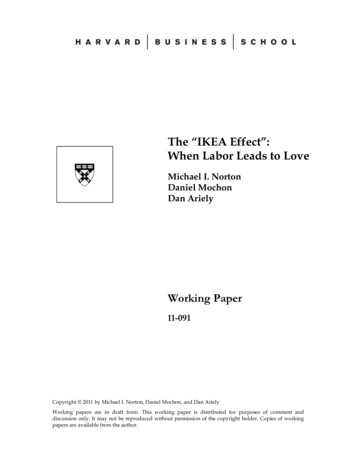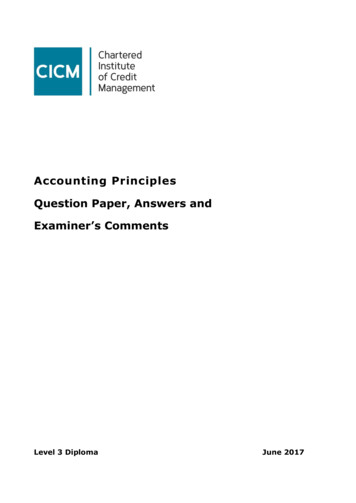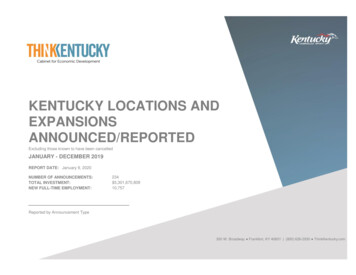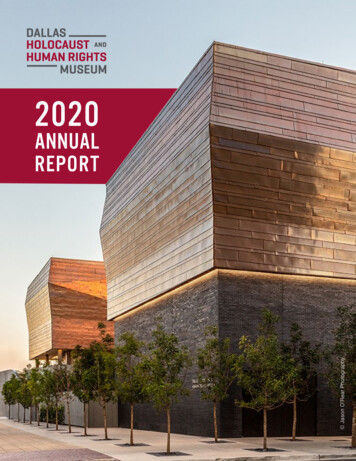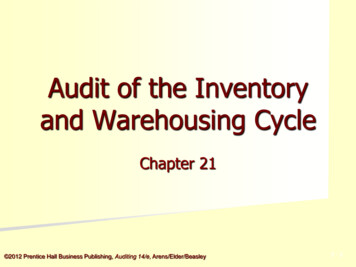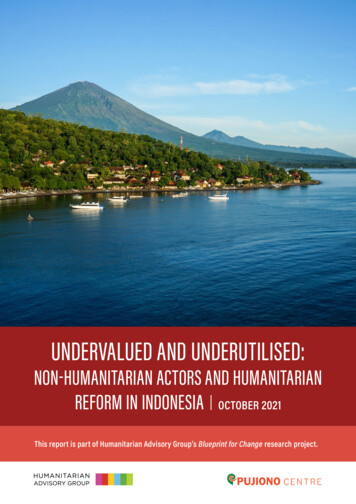
Transcription
UNDERVALUED AND UNDERUTILISED:NON-HUMANITARIAN ACTORS AND HUMANITARIANREFORM IN INDONESIA OCTOBER 2021This report is part of Humanitarian Advisory Group’s Blueprint for Change research project.
ACKNOWLEDGEMENTSAuthors: Jesse McCommon, Kate Sutton, Humanitarian Advisory Group; Puji Pujiono,Pujiono CentreResearch team: Puji Pujiono, Henny Vidiarina, Dio Fikri Aditama, Putu Hendra Wijaya,Disya Marianty, Pujiono Centre; Jesse McCommon, Eleanor Davey, Kate Sutton,Humanitarian Advisory Group; Surya Rahman Muhammad, Humanitarian ForumIndonesia; Harris Oematan, Jaringan Mitra Kemanusiaan; Arifin Muh Hadi, IndonesianRed Cross Society; Arif Nur Kholis, Muhammadiyah Disaster Management CentreResearch Editor: Eleanor DaveyCopy Editor: Campbell AitkenGraphic Designer: Jean WatsonCover photo: Lagoon with boats in small village Amed on the east of Bali, Indonesia.Volcano Gunung Agung is in the background. Yana Sutina / ShutterstockInternal photos: Panoramic view of rice field in Lombok Island. Ayip07 / Shutterstock;Lembang, West Bandung Regency, West Java, Indonesia. Devon Daniel / Unsplash;Mount Bromo, Indonesia. Atik Sulianami / Unsplash; Colourful fishing boats in Muncarvillage in Banyuwangi, Indonesia. Yavuz Sariyildiz / Shutterstock; Lagoon with boats insmall village Amed on the east of Bali, Indonesia. Yana Sutina / Shutterstock; Landscapeof Batur volcano on Bali island, Indonesia. oOhyperblaster / ShutterstockHumanitarian Advisory Group would like to thank all those who contributed to thispaper. This includes the Pujiono Centre team that led the research in Indonesia as wellas all the local, national and international actors who participated in this research. Wewould like to acknowledge special contributions from Surya Rahman Muhammad,Harris Oematan, Arifin Muh Hadi, and Arif Nur Kholis, who submitted briefing papers tosupplement this research. The research team would also like to thank Mia Marina, HeniPancaningtyas, Kharisma Nugroho and Jo-Hannah Lavey who provided peer review; aswell as the members of our Building a Blueprint for Change Steering Committee, whohave guided this research since its inception. HAG would also like to acknowledge thedifficult circumstances under which our partners have been working in Indonesia, as thepandemic reached a devastating peak at the time of this writing.HAG would also like to thank the Australian Department of Foreign Affairs and Trade(DFAT) for its contribution to this research. This report is a part of Humanitarian AdvisoryGroup’s Building a Blueprint for Change research, which has been conducted inpartnership with the Pujiono Centre. This research is part of the Humanitarian HorizonsResearch Program 2018–21, funded by DFAT.ii
INTRODUCING THE RESEARCHBuilding a Blueprint for ChangeBuilding a Blueprint for Change is a two-year research stream under Humanitarian Advisory Group’s HumanitarianHorizons research initiative. It aims to provide an evidence base to progress transformative change in thehumanitarian system at the country level.Humanitarian HorizonsHumanitarian Horizons is a three-year research initiative implemented by Humanitarian Advisory Group. Theprogram adds unique value to humanitarian action in Asian and Pacific contexts by generating evidence-basedresearch and creating conversations for change. The program is supported by the Australian Department ofForeign Affairs and Trade.WHO WE AREHumanitarian Advisory GroupHumanitarian Advisory Group (HAG) was founded in 2012 to elevate the profile of humanitarian action in Asia andthe Pacific. Set up as a social enterprise, HAG provides a unique space for thinking, research, technical adviceand training that contributes to excellence in humanitarian practice. As an ethically driven business, we combinehumanitarian passion with entrepreneurial agility to think and do things differently.We believe we cannot provide research or technical support in countries without the support and guidance ofnational consultants. Our experience is that national consultants improve the quality of our work by ensuring thatwe focus on the most relevant issues, providing contextual understanding to our projects, and enabling linkagesinto national and regional networks. We seek to engage national consultants for all our projects that involve incountry work; for us, this is both a principle and a standard way of working.Pujiono CentrePujiono Centre’s mission is to build effective multidisciplinary and intersectional knowledge by expanding thecapacities of practitioners and learners via innovation, tools and services. The Pujiono Centre promotes evidencebased policymaking in disaster management and climate risk reduction through the provision of credibleinformation.Humanitarian Advisory Group is BCorp certified. This little logo means we work hardto ensure that our business is a force for good. We have chosen to hold ourselvesaccountable to the highest social, environmental and ethical standards, settingourselves apart from business as usual.iii
TABLE OF CONTENTSivAcronymsvExecutive summary6I.Introduction92.Methodology113.The setting for reform in Indonesia154.Priority areas for reform in Indonesia234.1. Coordination234.2. Accountability274.3. Capacity304.4. Funding345.Implications for global humanitarian reform386.Conclusion41
ACRONYMSAAPAccountability to Affected PeopleAHA CentreASEAN Coordinating Centre for Humanitarian Assistance on disaster managementAKPIIndonesian Humanitarian-Development AllianceASBArbeiter-Samariter-BundASEANAssociation of Southeast Asian NationsBPDLHEnvironmental Fund Management Agency (Badan Pengelola Danan Lingkungan Hidup)BNPBNational Disaster Management Agency (Badan Nasional Penanggulangan Bencana)CGDCenter for Global DevelopmentCRSCatholic Relief ServicesCSOCivil Society OrganisationFGDFocus Group DiscussionGoIGovernment of IndonesiaHAGHumanitarian Advisory GroupIASCInter-Agency Standing CommitteeICRCInternational Committee of the Red CrossIFRCInternational Federation of the Red Cross and Red Crescent SocietiesINGOInternational Non-Governmental OrganisationMDMCMuhammadiyah Disaster Management CentreNEARNetwork for Empowered Aid ResponseNGONon-Governmental OrganisationOCHAUnited Nations Office for the Coordination of Humanitarian AffairsPEERPreparing to Excel in Emergency ResponsePKPUPenundaan Kewajiban Pembayaran UtangPMIIndonesian Red Cross (Palang Merah Indonesia)SOPsStandard Operating ProceduresUNUnited NationsWASHWater, Sanitation and HygieneWHSWorld Humanitarian Summitv
Description. PhotographerEXECUTIVE SUMMARYThis report is the final output of the Building a Blueprint for Change research project, led byHumanitarian Advisory Group and Pujiono Centre. It examines the conditions and drivers ofhumanitarian reform in Indonesia. The study was designed to apply a new approach to reform efforts,one which is built entirely around the local priorities and contextual factors of one country rather thanan attempt to adapt international agendas.The study focused on Indonesia because it was identified as the country with the most momentum forchange in the Asia Pacific region. Indonesia has been recognised for its leadership in nationalising andlocalising humanitarian response and has served as a prime candidate to explore opportunities for alocalised approach to humanitarian reform.Our research suggests that a key challenge for humanitarian reform in Indonesia is the tendency ofinternational agendas to put non-humanitarian actors in a marginal position despite their crucial rolein the vast majority of Indonesia’s frequent emergency responses. In a country that faces thousands ofnatural hazards each year, responsibilities for disaster response rest across a wide range of local actorsthat are generally not recognised by the conventional humanitarian system. This oversight results in theexclusion of key non-humanitarian actors from humanitarian coordination mechanisms, accountabilitypractices, capacity strengthening programs and funding opportunities – identified by Indonesianstakeholders as the four priority areas for reform.Findings demonstrate the need for greater recognition of and investment in these non-humanitarianactors, systems and structures in order for reform efforts to be effective and grounded in local realities.The study highlights the importance of reform priorities being nationally led and locally owned, withefforts unique to the strengths of each context rather than attempting to conform to the internationalmodel – while still drawing on expertise and opportunities from the conventional system. The researchwas not intended to propose specific mechanisms, rather to build an evidence base to supportIndonesia’s reform journey.6Undervalued and underutilised: Non-humanitarian actors and humanitarian reform in Indonesia
IN THIS REPORTThis report includes three main sections, which seek to:fOutline the reform context in Indonesia, including thecountry’s shift to more localised disaster response and theinsufficiently recognised role of non-humanitarian actorsfPresent findings about the four priority areas for reformin Indonesia to shed light on the challenges faced by nonhumanitarian actors and propose potential entry points forengaging these actors in a more inclusive reform process.This includes sections re the implications of the findings for the futureof humanitarian reform and specifically for the unfoldingGrand Bargain 2.0 process to highlight how learnings fromIndonesia can be applied in other contextsWhat do we mean by non-humanitarianactors?Our use of the term ‘non-humanitarian’ captures organisationsor individuals whose primary mandate is not explicitly inthe conventional remit of humanitarian response, yet whoparticipate actively in response activities in an intentional,institutionalised and planned manner. They include localcharities, private businesses, advocacy groups, religiousorganisations and others. Their mandates spread across allsectors of society, yet these non-humanitarian national, localcivil society and grassroots organisations are the principalactors in emergency responses in Indonesia.Undervalued and underutilised: Non-humanitarian actors and humanitarian reform in Indonesia7
Key FindingsCoordinationConventional humanitarian coordinationstructures are too top-down and generallydo not recognise or support the role of nonhumanitarian actors.f Despite progress, existing coordinationstructures vary in effectiveness andinclusivityf There is appetite for clearer systems andagreed ways of workingf Coordination forums are proliferatingAccountabilityRecommendationsAdapt coordination approaches to accountfor the role of non-humanitarian actors.f Identify opportunities to include nonhumanitarian actors in local coordinationplatformsf Invest in support for non-humanitarianactors that will allow them to meaningfullyparticipate in local-level coordinationf Strengthen humanitarian emergencycoordination by building on the broader,multisectoral, online coordination thattakes place during non-emergency timesNon-humanitarian actors have relationshipswith communities that could makeaccountability a reality, but they havebeen left behind in the technicalities ofthe conversation about accountability toaffected people.Replace the current focus on training with afocus on co-creating a shared understandingof accountability that incorporates bothinternational principles and local realities.f The AAP concept is mostly used byconventional humanitarian actors, it is notwidely shared or understood among localactorsf Use this shared understanding to developmore participatory ways for communities toinform decisionsf Find a shared language to express the goalof accountability to affected peoplef Non-humanitarian actors have no access toAAP standards and guidancef Non-humanitarian actors have untappedpotential to make AAP meaningfulCapacityFundingConventional humanitarian capacitystrengthening initiatives do not recognisethe importance of non-humanitarian actorsin preparedness and response, leverage theirexisting capacity, or align with their needs.Make capacity strengthening a collaborativelearning process, not one-way training,and incorporate more local and nonhumanitarian actors in its design anddelivery.f Capacity strengthening is too narrowlyfocused on conventional humanitarianagendasf Adopt a ‘life skills’ approach to include localand non-humanitarian actors in capacitystrengtheningf Key responders are missing out on thechance to learn and share their experiencef Embrace two-way learningf There are opportunities to learn from goodpracticef Consider identifying local ‘humanitarianchampions’ to become leaders whenscaling upLack of recognised contribution tohumanitarian response is reflected in lackof funding available to non-humanitarianactors.Develop a tailored, nationally managedfinancing mechanism for Indonesia thatrecognises the vital role of non-humanitarianactors.f The conventional humanitarian system isnot built to support local actorsf Organise inclusive conversations aboutinnovative financing to build consensus ona new national modelf Non-humanitarian actors lack access tofunds for disaster responsef There is currently no consensus about whatform a national funding mechanism shouldtake8f Incorporate insight from national as well asinternational experiencesUndervalued and underutilised: Non-humanitarian actors and humanitarian reform in Indonesia
1. INTRODUCTIONIndonesia has decisively embraced the shift to more assertive sovereignty in humanitarian responseoperations. Indonesia is recognised for ‘charting the new norm’ in limiting international support andnationalising response operations, for example during the 2018 Central Sulawesi earthquake response.1Momentum for this shift has been building for decades. After the 2004 Indian Ocean tsunamidecimated Aceh, international actors arrived in large numbers and were criticised for overwhelmingand side-lining national actors. Ever since, the Government of Indonesia (GoI) has undertaken disastermanagement reform to ensure the experience is not repeated. 2 The GoI has demonstrated greaterconfidence in responding to crises and has supported increasingly sophisticated local responses, asshown through responses to the Mt Merapi eruption in 2010, Pidie Jaya earthquake in 2016, Mt Agungeruption in 2017, and Lombok and Sulawesi earthquakes in 2018. 3Nonetheless, as in other countries, there are opportunities to improve. Indonesia has strong nationalresponse leadership and established humanitarian systems and structures, but persistent barriers,bottlenecks and inefficiencies remain. This report examines four areas that Indonesian stakeholdersidentify as priorities for reform: coordination, accountability, capacity and funding. While the reportaims to be practical, it does not prescribe specific mechanisms or technical features. Instead, it presentsthe views of key stakeholders on how reform efforts in the country have progressed so far, what is stillneeded, and what factors might contribute to the success of future efforts.The report’s overarching finding is that more needs to be done to account for the essential role of nonhumanitarian actors in disaster response in Indonesia. Its people face thousands of natural hazardseach year, so disaster response at various scales is a vital responsibility shared by many. Yet many firstresponders are undervalued, underutilised and largely ignored, because they do not fit easily withinthe conventional humanitarian system’s configuration. There must be greater recognition of theircontributions and investment in providing them with basic humanitarian competencies as part of a‘life skills’ approach, as well as integrating them into local and national coordination mechanisms. Thereport explains what this means in the Indonesian context and the implications for approaches tohumanitarian reform elsewhere.ABOUT THIS RESEARCHThis report is part of a project by Humanitarian Advisory Group (HAG) and the Pujiono Centre to identifyleverage points for systemic change in the humanitarian system in particular country contexts. It waspart of HAG’s Humanitarian Horizons research program, funded by the Australian Department ofForeign Affairs and Trade.The project aimed to elevate local voices and priorities to national and international reform discussions;it is hoped that Indonesian stakeholders will use the contents of this report to achieve this aim, as wellas to guide continuing reform efforts in Indonesia. The report also presents the international communitywith evidence of the merit of a localised approach to reform, revealing the many intricacies of a countrycontext that could never be fully addressed by sweeping global reform. It proposes a new way toreshape the humanitarian system, not by increasing commitments and upgrading agendas, but byturning the whole process on its head.123HAG and Pujiono Centre, 2019, Charting the new norm? Local leadership in the first 100 days of the Sulawesi earthquake response.HAG and Pujiono Centre, 2021, Shifting the system: The journey towards humanitarian reform in Indonesia; Willets-King, 2009, Therole of the affected state in humanitarian action: A case study on Indonesia, HPG Working Paper.Interviews 11, 24Undervalued and underutilised: Non-humanitarian actors and humanitarian reform in Indonesia9
STRUCTUREThe remainder of the report is divided into five sections.Section II explains the methodology and key concepts used inthe research, including the concept of non-humanitarian actors.Section III outlines the reform context in Indonesia, includingthe country’s position ahead of the curve in the shift to morelocalised responses and the insufficiently recognised role ofnon-humanitarian actors in disaster response. This section alsohighlights how the COVID-19 pandemic has affected Indonesiaand approaches to emergency operations.Section IV presents findings about the four priority areas forreform in Indonesia. It sheds light on the experiences anddifficulties faced by non-humanitarian actors as they navigatereform priorities that often fail to translate to the local level.It addresses the main challenges identified in Indonesia, andproposes potential entry points for engaging non-humanitarianactors in a more inclusive reform process.Section V explores the implications of the findings for thefuture of humanitarian reform and specifically for the unfoldingGrand Bargain 2.0 process, which builds on the first iterationof the Grand Bargain during the World Humanitarian Summit(WHS) in 2016. It highlights how learnings from Indonesia canbe applied in other contexts, and how the sector can continueto increase the meaningful inclusion of all actors involved inhumanitarian response.Section VI concludes the report.10Undervalued and underutilised: Non-humanitarian actors and humanitarian reform in Indonesia
2. METHODOLOGYGiven the frustration with many of the global and broad higher-level policy discussions, the Buildinga Blueprint for Change project sought to identify if greater traction could be found in the nationalexperience of humanitarian reform. The research was based on the premise that reform needs to beprioritised and led at the country level, based on – rather than adapting to – the particular needs ofeach context, while being continuously informed by reform dynamics at the global level. The researchfocused on Indonesia, because it was identified as the country with the most momentum and appetitefor change in the Asia–Pacific region. The project applied an action research approach, meaning theresearch team was actively involved in humanitarian change initiatives and activities, documenting theprocesses and results and using this as the data for analysis.RESEARCH FRAMEWORKThe Blueprint research set out to investigate the potential of nationally and locally led humanitarianreform in contrast to internationally driven efforts, and identify specific priorities, conditions and driversof reform in Indonesia that could be advanced by local and national actors to achieve transformativechange.The project focused largely on the national disaster management system in Indonesia, highlighting thatthis is distinct from (although it interacts with) the international humanitarian system. The distinctionwas important in maintaining the research focus on dynamics at the national level. While the reportrefers to the formal or conventional ‘humanitarian system’ to reflect the integration of multiple types ofactors in emergency response, it does not aim to analyse conflict settings and responses in detail.The project had two main phases. Phase 1 of the research engaged a diverse range of Indonesianstakeholders to map the humanitarian system in Indonesia and identify priorities for reform with thegreatest potential for systemic change. Data consistently identified and validated four key focus areas forthe research, as shown in Figure 1 below.4Figure 1: Priority areas for reform in Indonesia4CoordinationTo refine and clarify roles and responsibilities and to ensure coordination isinclusive of all actors responding.AccountabilityTo strengthen accountability to affected populations and all stakeholders.CapacityTo contextualise and expand capacity development programs to reach allactors as a priority for humanitarian resources.FundingTo improve access to and transparency of funding for national andlocal actors.For more information about Phase 1 of the Blueprint research, please see: HAG, 2020, Building a blueprint for change: Laying thefoundations.Undervalued and underutilised: Non-humanitarian actors and humanitarian reform in Indonesia11
Phase 2 of the research interrogated the prospects for reform through a targeted literature review,in-depth interviews, workshops and focus group discussions (FGDs). This report presents the phase2 findings, focusing on the four priority areas. It builds on the description of the country’s nationaltrajectory towards humanitarian reform and locally led response in HAG and Pujiono Centre’s literaturereview, Shifting the system: The journey towards humanitarian reform in Indonesia. It also highlightsand focuses on an overarching theme that emerged repeatedly across all four key areas: the importanceof engaging non-humanitarian actors.TERMINOLOGYThis report argues that non-humanitarian actors, structures and processes are undervalued,underutilised, and largely ignored in humanitarian reform efforts. This finding emerged from our studyin Indonesia, but we believe it is relevant elsewhere. But what do we mean by non-humanitarian actors?In discussions in and about the humanitarian sector, there often appears to be a self-perpetuated beliefthat organisations associated with this sector have a specific and distinctly identifiable mandate to actupon humanitarian imperatives, and that they are capable, organised, and resourced top-down fromthe national to the local level. The reality, of course, is much more complex.Disasters, emergencies and crises are multifaceted and not necessarily perceived or distinguishedas humanitarian crises. Most humanitarian action takes place in non-conflict settings where nationaland local governments are intact and organised; some may be overwhelmed by the crisis, but mostare capable of making decisions and carrying out emergency responses. Many national and local civilsociety organisations (CSOs) and non-governmental organisations (NGOs) have responded to multipledisasters over years or decades. Some may have worked alongside or with international actors, growingin sophistication, increasing their resources and building networks that may surpass those of many aidorganisations. Few of these organisations, however, have ‘humanitarian aid’ as their core mandate, or usethis language to describe their role during crises (see Box 1).Box 1. Non-humanitarian actors and systemsOur use of the term ‘non-humanitarian’ captures organisations or individuals whose primary mandateis not explicitly in the conventional remit of humanitarian response, yet who participate activelyin response activities in an intentional, institutionalised and planned manner. They include localcharities, private businesses, advocacy groups, religious organisations and others. Their mandatesspread across all sectors of society, yet these non-humanitarian national, local civil society andgrassroots organisations are the principal actors in emergency responses in Indonesia. Their effortsto assist affected communities in times of crisis and recovery are invaluable in meeting needs andreaching the most vulnerable.By using the term ‘non-humanitarian actor’, we are hoping to expand the understandings of ‘local’and ‘national’ actors to include a wider array of entities. This term has been used similarly by others,for example, to acknowledge the role of non-humanitarian actors in protection work and in thecontext of COVID-19. 5 In our usage, the term ‘non-humanitarian’ can also apply to systems andstructures.512InterAction, 2017, Implementing the IASC Protection Policy: What does it mean for NGOs?, available at y-What-does-it-mean-for-NGOs.pdf; IFRC and UNICEF,2020, Interim Guidance: Localisation and the COVID-19 response, in collaboration with IASC Results Group 1 on Operational ResponseSub-Group on Localisation, available at isation%20and%20the%20COVID-19%20Response 0.pdfUndervalued and underutilised: Non-humanitarian actors and humanitarian reform in Indonesia
International humanitarian labels and structures do not apply to every context; research has highlightedthe importance of challenging ‘the notion of a uniform local that takes the lead of the response.’6 Localresponders are interacting and coordinating with each other, with the government and with otherstakeholders in many ways outside the conventional humanitarian sphere. Different capacities and waysof working are developed over time that may not fit the mould required by international agencies. Theseshould not be dismissed, but built upon and learned from in tailored, country-led reform.It is important to note that this paper does not suggest that elevating and supporting the role of nonhumanitarian actors is the only change that needs to occur in Indonesia, but rather that it has beenan overlooked area with high potential dividends. Nor is it the intention of this research to ‘convert’them into humanitarian actors in the conventional sense; instead, this research argues for sufficientrecognition and investment for their capacity strengthening and inclusion in systems and structures atdifferent levels.METHODSThis report builds on two years of research in Indonesia (July 2019 – July 2021). It draws on the experienceand perspectives of a range of local, national and international actors across Indonesia and globallyusing a mixed methods approach, as represented below.3 stakeholderworkshops in Jakarta1 workshop with30 senior officials1 real-timeevaluation of a CSO1 Literature review24 interviews with70 documentslocal, national andinternational actors1 expert Steering4 peer reviewerstargeting more than 60participants to map thehumanitarian system inIndonesiaof Indonesian CSOsand NGOs to validateidentified reformprioritiesnetwork formed to aidthe COVID-19 response1 focus groupdiscussion on the4 briefing papers1 regional panel2021 West Sulawesiearthquake responseon identified reformpriorities from leadinglocal humanitarianorganisations andnetworks in Indonesiadiscussion on theintersect betweenglobal reform and localrealitiesofCommittee inIndonesiaData collection was conducted both in English and Bahasa Indonesia. Translation was supported by thePujiono Centre to ensure all actors’ views were captured accurately. In circumstances when transcriptswere not available, translated summaries were provided. In some instances, this prevented the use ofdirect quotes from local and non-humanitarian actors, but their views are embedded throughout thereport.This report is supplemented by four briefing papers produced by national partners in Indonesia. Thesebriefings serve to elevate local voices in the reform discussion and further contextualise local priorities inthe four focus areas of the research.7 The study also involved a resource review to draw together findingsand highlight learnings that may be relevant and applicable to other contexts and global discussions.67Melis and Apthorpe, 2020, The politics of the multi-local in disaster governance, Politics and Governance 8(4):370.For more information about the briefing papers, see HAG and Pujiono Centre, 2021, Local voices on humanitarian reform: A briefingseries from Indonesia.Undervalued and underutilised: Non-humanitarian actors and humanitarian reform in Indonesia13
Data from all sites and sources was analysed through thematiccoding, according to the four priority areas identified in phase1 of the project. The key informant interviews were particularlyimportant in the process of identifying early findings in each area.The researchers tested emerging findings in the focus groups andworkshop conversations.CONTEXTUALISING THE STUDYIn many ways, Indonesia is notably advanced in the journeytowards locally led response, yet looking at country-led reformthrough a holistic lens reveals that much progress remains to bemade. We believe Indonesia’s combination of strong leadershipand persistent challenges makes this a valuable case study thatoffers lessons for other contexts.The COVID-19 pandemic shaped the research context andconduct, significantly affecting data collection. HAG and PujionoCentre both collected data remotely. Participants, includinggovernment representatives, had to deal with public healthmeasures as well as other emergency
6 Undervalued and underutilised: Non-humanitarian actors and humanitarian reform in Indonesia Description. Photographer EXECUTIVE SUMMARY This report is the final output of the Building a Blueprint for Change research project, led by Humanitarian Advisory Group and Pujiono Centre. It examines the co
